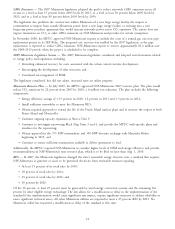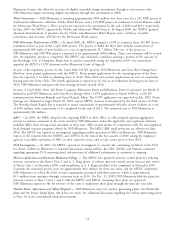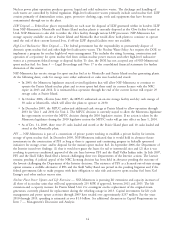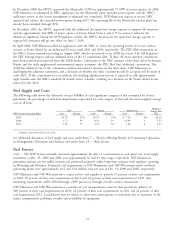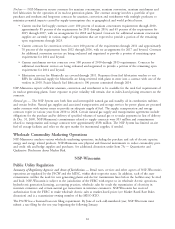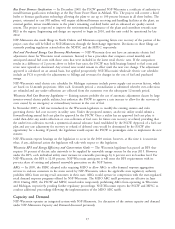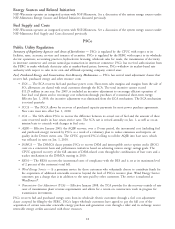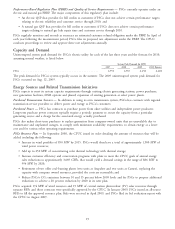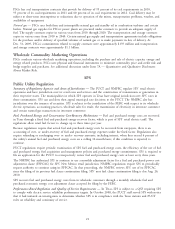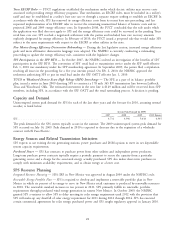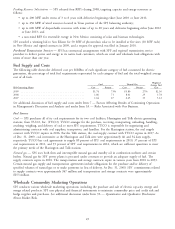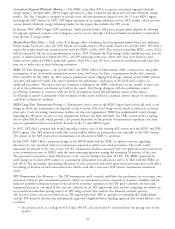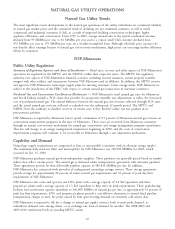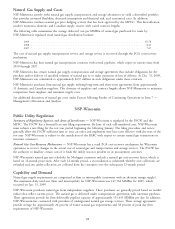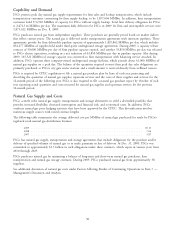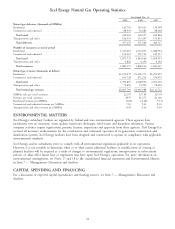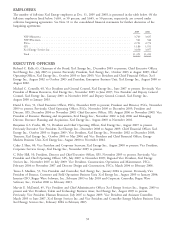Xcel Energy 2009 Annual Report Download - page 32
Download and view the complete annual report
Please find page 32 of the 2009 Xcel Energy annual report below. You can navigate through the pages in the report by either clicking on the pages listed below, or by using the keyword search tool below to find specific information within the annual report.
Texas EECRF Rider — PUCT regulations established the mechanism under which electric utilities may recover costs
associated with providing energy efficiency programs. That mechanism, an EECRF rider, must be included in a utility’s
tariff and may be established in a utility’s base rate case or through a separate request seeking to establish an EECRF. In
accordance with this rule, SPS has removed its energy efficiency costs from its recent base rate proceeding, and has
requested implementation of its EECRF rider to recover the remaining unamortized balance of historic costs and its
projected 2008 and 2009 energy efficiency costs. In September 2008, the PUCT concluded that the rule under which
the application was filed does not apply to SPS and the energy efficiency costs could be recovered in the pending Texas
retail base rate case. SPS reached a negotiated settlement with the parties and included base rate recovery amounts
explicitly designated for energy efficiency. In February of 2010, the PUCT issued a proposed rule that would make SPS
subject to the same requirements with respect to the EECRF as other utilities in the state.
New Mexico Energy Efficiency Disincentive Rulemaking — During the last legislative session, increased energy efficiency
goals and more affirmative disincentive language were adopted. The NMPRC is currently conducting a rulemaking
proceeding to update the energy efficiency rule, consistent with the legislative changes.
SPS Participation in the SPP RTO — In October 2007, the NMPRC ordered an investigation of the benefits of SPS’
participation in the SPP RTO. The conversion of SPS’ retail load to transmission service under the SPP tariff effective
Feb. 1, 2010 was mandatory under the SPP membership agreement. In September 2009, the parties filed a stipulation
resolving all issues in the proceeding for a five year interim period. On Feb. 2, 2010, the NMPRC approved the
settlement authorizing SPS to put its retail load under the SPP OATT effective Jan. 1, 2010.
TUCO to Woodward District Extra High Voltage (EHV) Interchange — The SPP, as a part of its balance portfolio
plan, issued a notice in June 2009 directing SPS to construct a 178 mile 345 KV transmission line between Lubbock,
Texas and Woodward, Okla. The estimated investment in the new line is $149 million and will be recovered from SPP
members, including SPS, in accordance with the SPP OATT and the retail ratemaking process. A decision is pending.
Capacity and Demand
Uninterrupted system peak demand for SPS for each of the last three years and the forecast for 2010, assuming normal
weather, is listed below.
System Peak Demand (in MW)
2007 2008 2009 2010 Forecast
SPS................................................ 4,731 4,996 5,038 4,945
The peak demand for the SPS system typically occurs in the summer. The 2009 uninterrupted system peak demand for
SPS occurred on July 14, 2009. Peak demand in 2010 is expected to decrease due to the expiration of a wholesale
contract with El Paso Electric.
Energy Sources and Related Transmission Initiatives
SPS expects to use existing electric generating stations, power purchases and DSM options to meet its net dependable
system capacity requirements.
Purchased Power — SPS has contracts to purchase power from other utilities and independent power producers.
Long-term purchase power contracts typically require a periodic payment to secure the capacity from a particular
generating source and a charge for the associated energy actually purchased. SPS also makes short-term purchases to
comply with minimum availability requirements, and to obtain energy at a lower cost.
SPS Resource Planning
Integrated Resource Planning — SPS’s IRP in New Mexico was approved in August 2009 under the NMPRC’s rule.
Renewable Energy Portfolio Plan — SPS is required to develop and implement a renewable portfolio plan in New
Mexico in which six percent of its energy to serve its New Mexico retail customers is produced by renewable resources
in 2010. The renewable standard increases to ten percent in 2011. SPS primarily fulfills its renewable portfolio
requirements through purchased wind energy generation in eastern New Mexico. In October 2009, the NMPRC
granted SPS a variance to allow SPS to delay meeting its solar energy requirement until 2012 with the provision that
SPS will make-up any shortfall of solar energy requirement for 2011 during 2012 through 2014. SPS has executed
certain commercial agreements for solar energy purchased power and SPS sought regulatory approval in January 2010.
22


